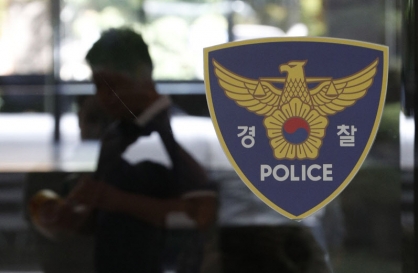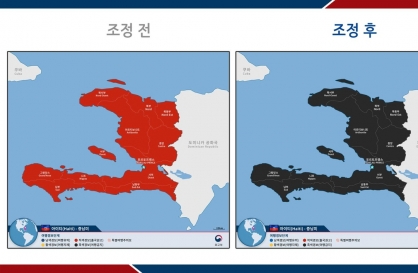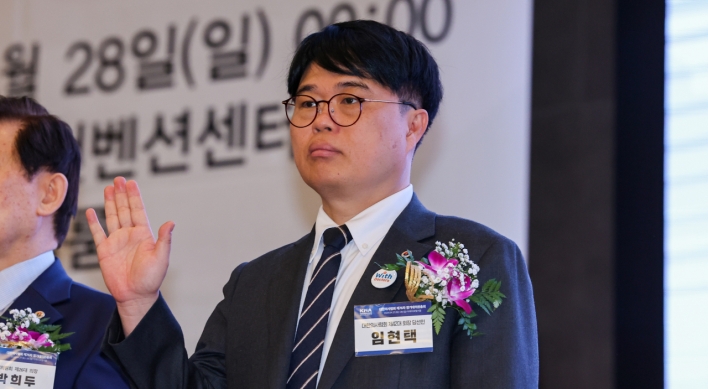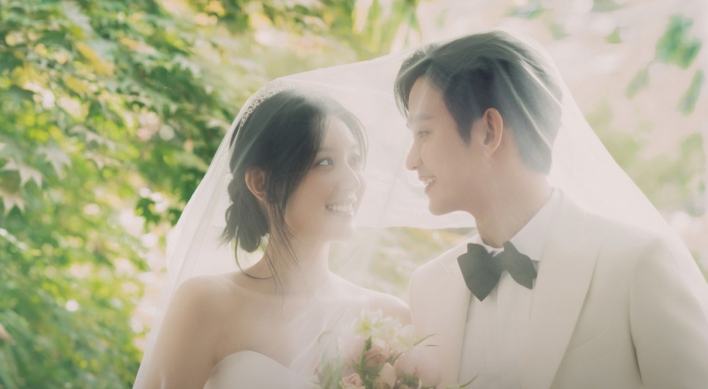Nestled in the design books section of Kyobo Book Center in Gwanghwamun, Seoul, calligraphy workbooks are displayed in a separate stall as a special collection.
According to Kyobo Book Center, calligraphy books began gaining traction since 2012, with the number of new publications and demand for them steadily growing each year.
According to Kyobo Book Center, calligraphy books began gaining traction since 2012, with the number of new publications and demand for them steadily growing each year.
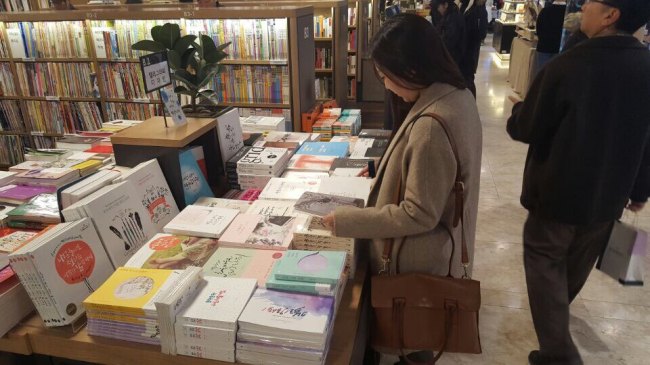
In 2013, eight new books on calligraphy were published. Three years later in 2016, with more people taking interest and publishers finding profitability in the topic, the number swelled to 53.
The on-year demand for calligraphy books peaked in 2014, growing 230 percent.
Calligraphy books, featuring inspirational quotes written in flowery writing, encourage ordinary readers to take up the artistic practice at home for fun.
Readers are promised that once they become confident in their own styles, they would be able to write one-of-a-kind cards to special people -- and even use the calligraphy skills to create potentially commercial products such as calendars, mugs and smartphone cases.
Six people stopped to leaf through the books at the stall in a span of just 15 minutes.
In that stall lay co-authors Jang Yong-a and Jeon Hyun-young’s “Calligraphy: Dressing Words with Style” (literal translation). It is the only book currently in the market that has equal weight of both Korean and English-language calligraphy guidelines in one volume. Having sold out two printings within three months of publication, Jang and Jeon are success cases of the calligraphy boom.
Speaking to The Korea Herald at their studio, Jang and Jeon shared their background and how their differing personalities drew them respectively to Korean and English calligraphy.
The on-year demand for calligraphy books peaked in 2014, growing 230 percent.
Calligraphy books, featuring inspirational quotes written in flowery writing, encourage ordinary readers to take up the artistic practice at home for fun.
Readers are promised that once they become confident in their own styles, they would be able to write one-of-a-kind cards to special people -- and even use the calligraphy skills to create potentially commercial products such as calendars, mugs and smartphone cases.
Six people stopped to leaf through the books at the stall in a span of just 15 minutes.
In that stall lay co-authors Jang Yong-a and Jeon Hyun-young’s “Calligraphy: Dressing Words with Style” (literal translation). It is the only book currently in the market that has equal weight of both Korean and English-language calligraphy guidelines in one volume. Having sold out two printings within three months of publication, Jang and Jeon are success cases of the calligraphy boom.
Speaking to The Korea Herald at their studio, Jang and Jeon shared their background and how their differing personalities drew them respectively to Korean and English calligraphy.

Jang Yong-a, 25, was an animation art major who had gone into poster design. It was during the time she was employed at a design company that she began to notice posters made with customized handwritings and not the usual digital fonts.
Thinking calligraphy skills would be an asset to her poster-making, Jang signed up for calligraphy classes -- which eventually led to her quitting the regular job. Apart from being an author, Jang is now a self-employed artist who runs calligraphy classes called “Zzangyong Calligraphy.” She writes for pay on demand.
Jeon Hyun-young, 32, also found her life renewed and invigorated after becoming acquainted with the world of calligraphy. Jeon had quit her job after getting married. As a full-time housewife, she took up calligraphy as a productive hobby. What started out as simple curiosity soon got Jeon hooked with a passion to do better in the field. Jeon also runs weekend classes with Jang, and regularly displays her work at exhibitions using her penname “Souleye.”
Jang and Jeon made an unlikely pair of friends due to their contrasting personalities and preferences. While Jang found joy in expressing her character through the boundless styles of Korean calligraphy, Jeon found reassurance in the exacting English calligraphy that could be mastered with due training.
English calligraphy has strict rules to follow -- this provides a clear-cut set of do’s and don’ts. Jeon said that ironically, her lack of English understanding helped her perform better in calligraphy. “I can solely focus on the visual aesthetics of the letters and treat them like paintings, not writing.”
“But of course it was double the work when I had to come up with my own sentences for the book to avoid copyright issues,” Jeon said.
Jeon said she got help from an acquaintance who majored in English to write meaningful messages for the book.
For Jang, the restrained manner of English-language calligraphy is the opposite of what she sets out to achieve with Korean calligraphy.
Thinking calligraphy skills would be an asset to her poster-making, Jang signed up for calligraphy classes -- which eventually led to her quitting the regular job. Apart from being an author, Jang is now a self-employed artist who runs calligraphy classes called “Zzangyong Calligraphy.” She writes for pay on demand.
Jeon Hyun-young, 32, also found her life renewed and invigorated after becoming acquainted with the world of calligraphy. Jeon had quit her job after getting married. As a full-time housewife, she took up calligraphy as a productive hobby. What started out as simple curiosity soon got Jeon hooked with a passion to do better in the field. Jeon also runs weekend classes with Jang, and regularly displays her work at exhibitions using her penname “Souleye.”
Jang and Jeon made an unlikely pair of friends due to their contrasting personalities and preferences. While Jang found joy in expressing her character through the boundless styles of Korean calligraphy, Jeon found reassurance in the exacting English calligraphy that could be mastered with due training.
English calligraphy has strict rules to follow -- this provides a clear-cut set of do’s and don’ts. Jeon said that ironically, her lack of English understanding helped her perform better in calligraphy. “I can solely focus on the visual aesthetics of the letters and treat them like paintings, not writing.”
“But of course it was double the work when I had to come up with my own sentences for the book to avoid copyright issues,” Jeon said.
Jeon said she got help from an acquaintance who majored in English to write meaningful messages for the book.
For Jang, the restrained manner of English-language calligraphy is the opposite of what she sets out to achieve with Korean calligraphy.
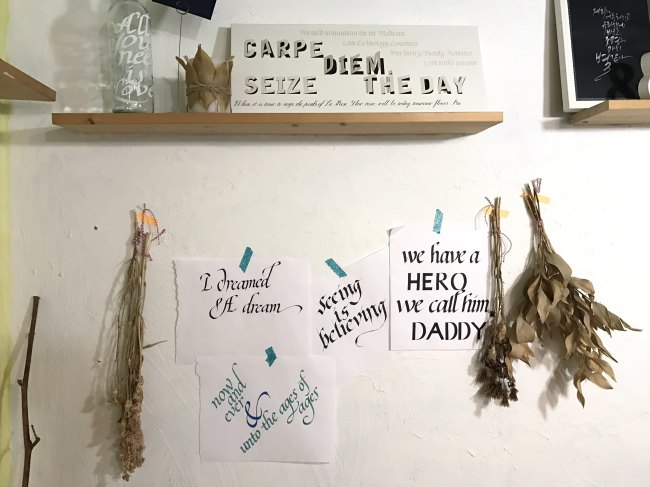
“What I write reflects my feelings at the moment, or the concept of the word,” she said. Behind her hung a calligraphy draft that read, “I will destroy you,” in comically harsh strokes. The power with which it was written was palpable, giving the two-dimensional writing an effect like that of a punch.
“For a word like ‘wind,’ I would use a slim brush to make the word look like it’s fluttering. For ‘boiling’ I would write it to resemble boiling water,” Jang said.
Both refuted the popular misbelief that calligraphy can help improve handwriting.
“Many people come to us looking for a way to correct illegible handwriting,” Jeon said, “But calligraphy can’t help, because it is more painting than writing.”
Jang hoped her readers would still take on calligraphy to discover the joy of expressing themselves through well-written messages, especially for special occasions.
By Lim Jeong-yeo (kaylalim@heraldcorp.com)
“For a word like ‘wind,’ I would use a slim brush to make the word look like it’s fluttering. For ‘boiling’ I would write it to resemble boiling water,” Jang said.
Both refuted the popular misbelief that calligraphy can help improve handwriting.
“Many people come to us looking for a way to correct illegible handwriting,” Jeon said, “But calligraphy can’t help, because it is more painting than writing.”
Jang hoped her readers would still take on calligraphy to discover the joy of expressing themselves through well-written messages, especially for special occasions.
By Lim Jeong-yeo (kaylalim@heraldcorp.com)
-
Articles by Korea Herald








